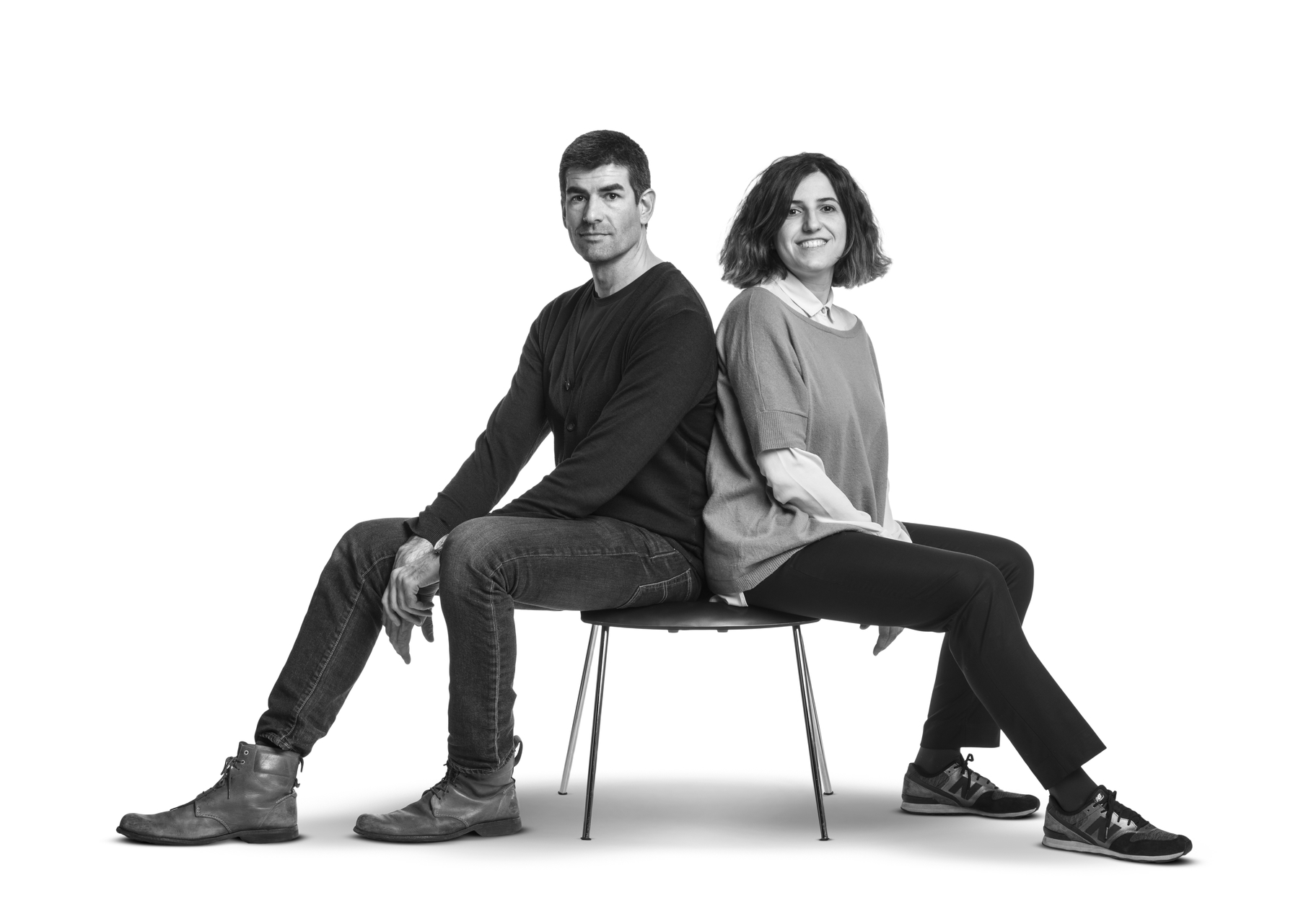menu
Info

Dani Vila & Ester Pujol interview by Guillem Ferran
Guillem Ferran interviews Ester Pujol and Dani Vila, the product designers at the helm of Nahtrang Studio, about the lighting industry, the products the studio has developed, and Nexia’s future.
Dani Vila
& Ester Pujol
Interview by
Guillem Ferran

Guillem: What does Nexia represent to you? What could you highlight?
Ester: To be involved in these projects has given us the chance to take part in the brand’s new positioning and their new product approach.
Dani: Up until this point, Nexia had always been associated with quality of light. The company didn’t focus so much on the identity of its products, but on an optimal management of light.
E This made it clear that it was necessary to imbue the catalog’s new products with more personality.
D Nexia was sober, functional, and met – by far – the requirements that are implicit in lighting up a space, but it lacked presence.
E It also lacked interactivity and the possibility of enabling people to personalise the product. Prescribers, final users… people, in the end, are what’s most important.
G What does this new collection express?
E A formal break from the products that were already in their catalog, and a foray into the use of new colours and materials.
D A greater sense of identity and singularity: each of the collections we have presented strives to find balance between form and technical expertise. Nexia couldn’t be understood but as a combination of both design and technology.
E To not only work with the quality of light but also with the object, given that technical light control is already a defining trait of Nexia’s products.
D To generate a series of objects that are warmer, more human and, ultimately, more visible in a given space.
G How do you think the industry is evolving?
E The industry of light is increasingly at a turning point. We’re getting used to seeing how companies that have a tradition in domestic or decorative lighting take a step further to realise projects that have more to do with contract and interior design. On the other hand, it’s not as common to see technical companies manage to get closer to the final audience with designs that are friendly – this particular fact has made the project all the more interesting to us.
G What do your proposals provide?
D To humanise a product that was in itself very technical was an incentive. Our proposals have brought us closer to the end users, and we’ve strived to make the designs recognisable both in form and in function.
G Among your different proposals, have you designed systems of luminaires?
D Yes. For a company like Nexia, systems are very important as they offer configurations that can be adapted to all types of project solutions. Systems are necessary to understand, interpret and light up an entire space.
E We’ve created elements with a strong presence that also manage to fit in with different environments, and provide a lot of compositional flexibility.
G What was the process of working with Nexia like?
D It was a very intense and stimulating process. We wanted to understand and provide an outlet for the company’s concerns, and we did our best to prioritise their needs when it came to proposing concepts that we deemed interesting.
E We had several meetings with the goal of acquiring a better understanding of the brand and its market, and to analyse in which direction other technical companies were headed in order to create a path that was unique to Nexia.
D The connection took place very quickly, and Nexia trusted our judgement without reservations.
E It’s also worth mentioning that the job was carried out as a team from the beginning – a collaborative effort from the marketing and technical departments, and ourselves.
D This close partnership was ultimately to thank for an outcome that we’re very happy with.
G What would you highlight about Tires?
D Among all of our proposals, it’s the most decorative one: we’ve simplified well known shapes that are versatile, exchangeable and make it possible to convey different emotions.
E It combines the philosophies of both Nahtrang and Nexia, from the diffuser to the way parts are affixed… and, above all, colour: we added natural and neutral hues to a catalog that was mainly populated with white, black and silver products.
G How did you find the archetype to create a piece that feels so familiar?
G How did you find the archetype to create a piece that feels so familiar?
DWe’ve acquainted ourselves with the Nordic tradition and style, with the influence of other companies that have been out there for quite a while.
E These are pieces that have a presence in our collective subconscious as theNordic heritage. We’ve worked with proportions and relationships between basic shapes that result from the process of metal spinning.
D The details communicate that we’re in front of a simple product, where it becomes evident whether the piece is well made or not. The upper parts feature amembrane that gives them a technological touch.
G What about Bow?
E It’s a sculptural piece that looks to destabilise the archetypal lamp, stepping away from symmetrical shapes.
D It’s meant for everyday uses where light accompanies instead of bothering the user. This product allows for both direct and indirect light.
E It’s hairline and it’s meant to project as little light as possible – especially in common settings like hotel rooms, where upon entrance it’s not unusual to find oneself bothered by light instead of feeling welcomed by it.
D Keeping in mind such situations, where people prefer to have a relaxed and intimate moment, we first came up with the light and subsequently moved on to the physical element that had to sustain it.
E We also tried to open up new routes by working with common elements that provide a lot of flexibility: to move and adjust the light according to the needs of each person.
G Aros makes it possible to combine direct and indirect light; general and accent light. What characterises Aros?
D It’s a direct consequence of breaking away from extruded square sections, the 90-degree linearity we’ve seen in previous catalogs. We’ve looked for something very basic that combines direct, reflected and focused light in a single element.
E It breaks away from the reticular and modular language they’re used to.
D With Aros, we can set up spaces in ways that aren’t as rational: constellations hanging from the ceiling, in a disorganized yet controlled way.
E It’s a dynamic and customisable luminaire – an element with many possibilities when it comes to variation, growth and simplification.
D It enables the projection of light toward the user or the ceiling, and it has features that make it easier to light up versatile spaces. It’s a product that lends itself to the creation of various points of interest.
G What makes Mobile special?
D Mobile stems from the need of combining acoustics with a language that is unique to Nexia.
E It’s very rational in the combination of the acoustic panel with the light: the dual function of lighting and softening a space’s acoustics.
D In a way that’s visually pleasant, too: the combination of materials can be very gratifying when done with a degree of coherence.
G Is it actually a movable luminaire?
E The panel can be adjusted and is very versatile indoors, either by placing lamps in a row or by playing with rhythm. In the design of this type of projects, the effort goes towards imagining the product working well in isolation but also as part of a group, opening up possibilities for any interior design project.
D It kind of looks like a swing. It’s a multifaceted piece.
G How do you see Nexia evolving in the coming years?
E The company sits at the beginning of a path that leads to endless destinations. There’s a lot to explore in the ways in which technology gets implemented in the industry of light.
D If they keep up with their performance in the knowledge of light, they’ll do very interesting projects. Nexia has taken a major qualitative leap in a short time: it’s a company that is committed to innovation amid a myriad companies that aren’t willing to step out of their comfort zone.
E They’ve been aware of the need to step up in order not to fall behind, and continue to develop products that have identity and personality.
G A different and dynamic collection proposal that will surely bring poetics and versatility to countless spaces.